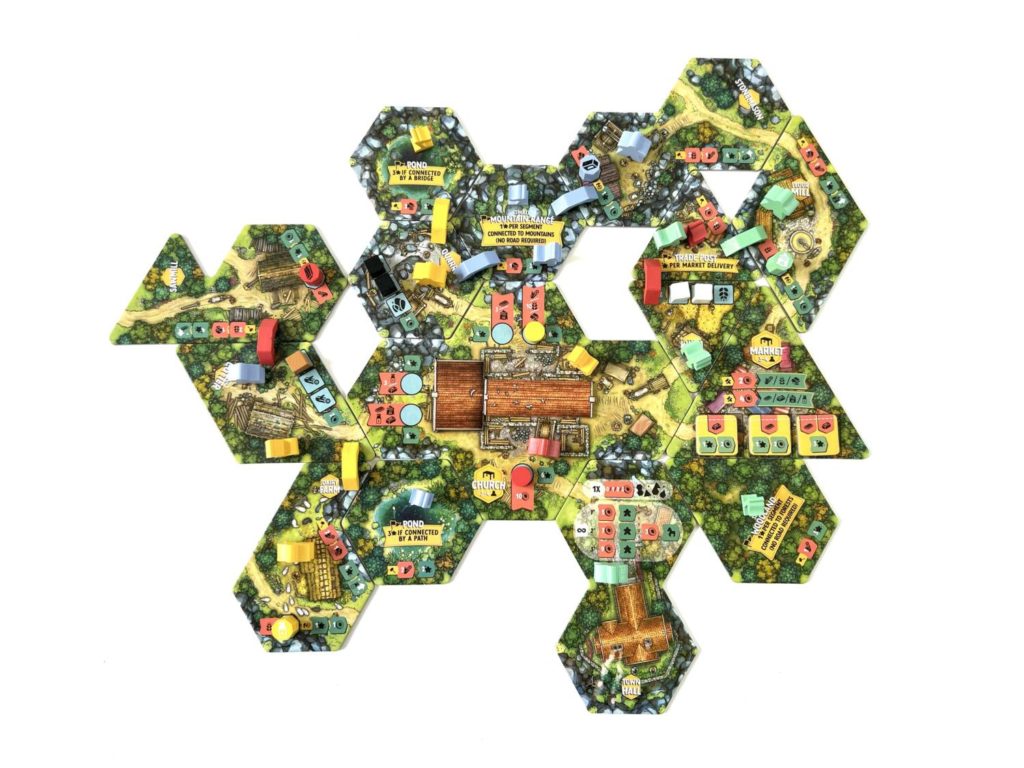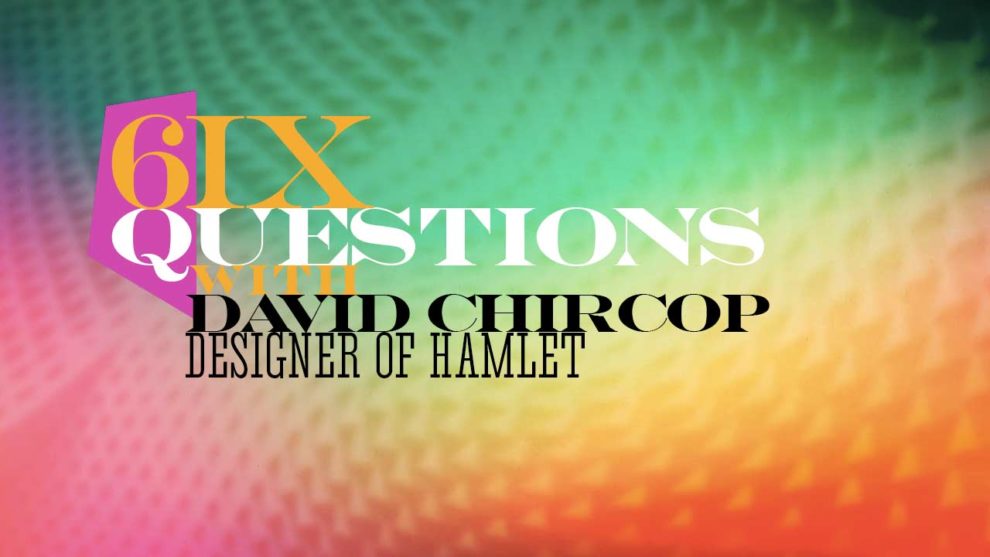Over the last eight years, David Chircop has shared unique designs with the tabletop industry. Whether gamers are invited to take up and unfold the life of a human character in The Pursuit of Happiness (co-designed with Adrian Abela), explore rocky relationships in …and then, we held hands, or compete for rain-soaked real estate as clouds in Petrichor, his titles are sure to provide a fresh experience. David has a knack for keeping eyes on the table and creating engaging, interactive spaces.
In March of 2022, David and the team at Mighty Boards completed a successful crowdfunding campaign for Hamlet: The Village Building Game. As the project comes to fulfillment and reaches the wider retail space during what they’ve deemed #HamletWeek, David has been kind enough to answer a few questions for the readers at Meeple Mountain.
Thank you so much for taking time to share with the readers of Meeple Mountain. I’d like to start with a question about Hamlet: The Village Building Game, a fresh release that attracted twice the backers of any other Mighty Boards crowdfunding campaign. Why do you think there was such a draw to this particular title? Was the initial buzz expected, and did it create any particular pressures?
Hamlet had the right look, the right video, the right price and the right “Fantasy”. All of those things complemented each other in such a way that it scratched a core itch in many people. The fantasy of village building is one that is universal, and there were many who wanted that same itch that I wanted scratched in a way that is a little bit different. The price was affordable. The game looks very pretty, thanks to Yusuf’s art… My vision for the video also managed to come through really well, and was able to explain why I made Hamlet, and what is the feeling the game is trying to communicate.
Overall, I think it was a combination of things done reasonably well that supported each other to reach a greater whole.

I’d love to know more about the development of the unusual geometry of the tiles in Hamlet. Was there a journey that carried you to such an eclectic array of polygons in a world that thrives in hexes and polyominoes?
Oh yes. So Hamlet started off as an entirely freeform game. It was played in a finite area – surrounded with a fence – and all buildings were just placed anywhere within it. Bigger buildings took up more space and that was the “built-in ” cost. You then needed to connect them with roads, so the farther things were, the longer roads you had to build. The core idea of Hamlet was always to create a sense of place. Buildings are far away from each other, so you need to work harder to deliver things between them. So I started from this very spatial, freeform, chaotic idea, which needed some more control to it. I wanted to introduce as little control of space as possible while still maintaining the organic growth of a village. Eventually I started experimenting with combinations of shapes, and I tried making a bunch of different shapes by combining triangles and hexes. I noticed that any combination of these shapes always created one of two angles, and that meant it would always allow any shape built from triangles and hexes to fit in. This was totally by accident. I am not a mathematician.
This meant that I could have ordered chaos, in some way, which to me is much more representative of the natural growth of villages and towns, at least in Europe in medieval times where there was no concept of “planned cities”. The irregular shapes simulate the irregular terrain, the land that you have to work with, and force some sort of adaptation from the player, into something that is formed in collaboration between the players as well as the game.
The final version of Hamlet is played on a triangular grid. I didn’t know that when I started making the game and playing with the shapes. The grid emerged as the smallest division of the shapes I was using. But that grid is meant to be out of view. There is “order”, but it’s designed to fade away. So although the grid IS there, it’s not obvious or at least players don’t pay much attention to it. I didn’t even realize it was there until after I had a working game. Perhaps that’s because I started from a very different place, or maybe I’m a bit slow, who knows 😀 ?

With games like Hamlet, Petrichor, and …and then, we held hands in your design portfolio, you seem to have a knack for developing interactive environments. Can you discuss your view on the importance of attentiveness and interaction in tabletop games?
Huh, I like that you call them “Interactive Environments”. I call them sandboxes, or maybe systems for emergence. The core of it all is that for me, what you receive in the box when you buy a game is fundamentally incomplete. A board game only becomes “the game” once you plug-in people into the rules and “props” that they purchased. For me, this “people” part is not 5 or 10 percent of the game, it’s more like 50 percent of it. So the systems I make tend to be constructed a bit like playgrounds of structure for the “plugged-in” people. This does mean that depending on the people you plug in, the game will change significantly – but how can it not! Players are half of the game!
Attentiveness is another thing altogether for me, and a little bit more technical than artistic. It’s one thing I’m trying to get better at, and learn more on how to engage with the subject overall. There are models of attentiveness, timing, prompts for action and all that – and maintaining attention gets harder and harder every year. I tend to use interaction and the human element itself as a glue for attention rather than the mechanics themselves calibrated to call for your attention at specific time intervals.
The reason for this is that I think that I am surrounded every day by systems that are carefully calibrated to call for, and maintain my attention. Board games, for me at least, are a moment of respite from all that – and therefore in my games I focus on more organic ways of maintaining attention that directly project to theme, fantasy, freeform play and human interaction.
This is something of a “chicken or the egg” question, but one that always grabs my attention. Which comes first for you as a game designer: theme or mechanics, and why?
A game is made of many layers of chickens and eggs stacked on top of each other. Bear with me…
Let’s for the sake of argument assume that a chicken is a thematic fantasy and an egg is a mechanic. The start for me would be a chicken and an egg that have a strong connection to each other. I place these next to each other as a base, with a string between them that links them – hence a mechanic that has a strong thematic justification. Then I continue to stack chickens on top of each other and eggs on top of each other. Each new chicken that I add I try to add a corresponding linked egg on the other side, and vice versa.
When the game is finished I have a column of chickens, and a column of eggs, with a bunch of strings going between them. It looks a bit like a chicken-egg ladder, but all the steps are jumbled-up a bit. Sometimes a few steps are missing, and sometimes I don’t always have a perfect 1:1 egg-to-chicken ratio. But you always need to be able to somehow climb it to the top. Makes sense yeah? Cool.

You have now released games and fulfilled Kickstarters before, during, and (I say with continuing optimism) after the brunt of the Covid-19 pandemic. What do you see as the most prominent effect of the last three years on the tabletop industry? Are there ways the crisis has made Mighty Boards a stronger or more resilient publisher?
The pandemic has forced us to become increasingly more organized, precise and optimized for us to be able to keep delivering (We are still getting better at this). Hamlet delivered on time, within the same year of it going to Kickstarter – in some regions even early. The amount of business, logistical and design gymnastics that this required I cannot even begin to remember. To the extent that all of 2022 is a big blobby blur of frantic calls, frowned-faced loud typing, and constant plan changes. But I, and our incredible team (love you gals n’ guys, you’re awesome) have learned a lot. We’ve made a lot of mistakes too, and we’re trying to write them down (still frantically) so as to learn from them.
This year we have also set up a new distribution network in the US, and started being a lot more prominent and visible in fairs there, which has always been an important region for us, but always incredibly difficult to work with. Especially since we come from, and are located on a tiny mediterranean island where things work very very differently, culturally and business-wise.
We’ve taken a lot of risks during the pandemic, some of them rewarded, some of them (frantically) noted as blunders.
The biggest single effect on the industry is – of course – logistics. This was always the most expensive thing about board games, and now it has greatly surpassed material cost in terms of the price cost of a game. We work in physical objects that are occasionally quite large. Being from an island, where logistics are even harder is the second of the proverbial one-two uppercut that could knock us out.
So far we stand, mostly thanks to the communities we have managed to build around our very different game lines. So we thank you, our backers and fans <3 – big hug from Malta!
When it comes to blending the business and the hobby, what does it look like for you to balance play as work and play for the sake of play? What games from other publishers have had your attention lately?
This is another thing that we have been working to improve. Some weeks we’re doing great, some weeks not so. We try to organize bi-weekly events at the office and outside to play other people’s work. Games arrive at the office constantly, and we try to play everything.
Recently we’ve been enjoying Beast together, Hansa Teutonica has been quite a hit, as well as Guild of Merchant Explorers. I’ve completely worn out my Scout deck. Tribes of the Wind has been well received too.
We’re also working very hard on our narrative action/adventure game Fateforge: Chronicles of Kaan, so we have been researching similar games – Oathsworn, Descent, oh and there is a box of Frosthaven that lies unopened on the shelf that I SWEAR sometimes whispers things to me while I work… weird.
Then there’s been a few oldies that I always go back to for comfort. Mottainai and Haggis live in my backpack and are pulled out between courses at restaurants. Occasionally I still visit the little shrine I built in my basement for Tigris & Euphrates and Brass. I don’t have too much time to play them, but I leave a flower and a candle there, right under the oil painted portraits of Mr. Knizia and Mr. Wallace.
Look for Meeple Mountain’s review of Hamlet: The Village Building Game for more on the current title; and keep your eyes peeled for an array of media content introducing this newest game during #HamletWeek.













Add Comment